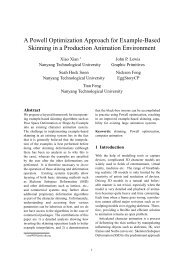Pose Space Deformation Notes - JP Lewis
Pose Space Deformation Notes - JP Lewis
Pose Space Deformation Notes - JP Lewis
You also want an ePaper? Increase the reach of your titles
YUMPU automatically turns print PDFs into web optimized ePapers that Google loves.
of the needed weight, or by having one of the weights be huge and offset by a large<br />
negative weight on the other row. This last scenario is undesirable of course.<br />
In general this would mean that your selection of basis functions is poor, and the model<br />
should be understood better. In the PSD case however the user chooses the “basis functions”<br />
(sculpted poses) and you (the programmer) has no control over what is chosen.<br />
Regularization is an adequate solution in this case: Add a soft constraint that votes for<br />
the weights to be not too large. i.e., minimize<br />
e = (Rw − d) 2 + λw ′ w<br />
(’ = transpose, so w ′ w = ||w|| 2 ) w=the weight vector, λ is a small user-defined scalar<br />
like 0.01.<br />
Taking derivative with respect to the weights gives a nice result:<br />
de/dw = 0 = 2R ′ (Rw − d) + 2λw<br />
R ′ Rw − R ′ d + λw = 0<br />
(R ′ R + λI)w = R ′ d<br />
w = −(R ′ R + λI) −1 R ′ d<br />
so in practice you can just add a small constant like 0.001 to the diagonal before inverting.<br />
There is some further analysis (which I forget for the moment) that points out that<br />
when a diagonal element of R’R is already large (corresponding to an element of w<br />
that will turn out small) then adding 0.001 to that diagonal element affects things little,<br />
but when the diagonal element is small (and the corresponding element of w would end<br />
up being huge), adding 0.001 will make a big difference. So this selectively affects the<br />
problematic weights much more than others.<br />
The 0.01 should be a user-adjustable parameter. I’m not sure how to explain to the<br />
users what it means!<br />
Different RBF kernel widths at different points<br />
This can be implemented simply. In the matrix instead of having<br />
[R(1,1), R(1,2), ...;<br />
R(2,1), R(2,2), ...<br />
...]<br />
where R(1,2) means the rbf kernel R() indexed by the distance between points 1,2, one<br />
would have<br />
[R1(1,1), R2(1,2), ...;<br />
R1(2,1), R2(2,2), ...<br />
...]







